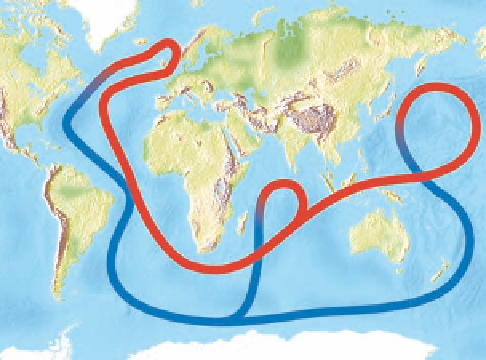Environmental Engineering Reference
In-Depth Information
intensified coastal storms and hurricanes, and tropical
waterborne and insect-transmitted infectious diseases
spreading rapidly beyond their current ranges.
These possibilities were supported by a 2003 analy-
sis carried out by Peter Schwartz and Doug Randall for
the U.S. Department of Defense. They concluded that
global warming “must be viewed as a serious threat to
global stability and should be elevated beyond a scien-
tific debate to a U.S. national security concern.” In 2004,
the United Kingdom's chief science adviser, David A.
King, wrote, “In my view, climate change is the most se-
vere problem we are facing today—more serious even
than the threat of terrorism.”
Warm, shallow
current
Cold, salty,
deep current
Figure 16-9
Natural capital:
A connected loop of shallow
and deep ocean currents stores CO
2
in the deep sea and
transmits warm and cool water to various parts of the earth. It
occurs when ocean water in the North Atlantic near Iceland is
dense enough (because of its salt content and cold tempera-
ture) to sink to the ocean bottom, flow southward, and then
move eastward to well up in the warmer Pacific. A shallower
return current aided by winds then brings warmer and less
salty—and thus less dense—water to the Atlantic. This water
can cool and sink to begin the cycle again. A warmer planet
would be a rainier one, which, coupled with melting glaciers,
would increase the amount of fresh water flowing into the North
Atlantic. This could slow or even jam the loop by diluting the
saltwater and making it more buoyant (less dense) and less
prone to sinking.
16-3 FACTORS AFFECTING
THE EARTH'S TEMPERATURE
Scientists have identified a number of natural and hu-
man-influenced factors that might
amplify
or
dampen
projected changes in the average temperature of the
troposphere. The fairly wide range of projected future
temperature changes shown in Figure 16-8 results from
including what is known about these factors in climate
models. Let us examine some possible wild cards that
could make matters worse or better during this century.
Science: Can the Oceans Store More CO
2
and Heat?
There is uncertainty about how much CO
2
and heat
the oceans can remove from the troposphere and how
long they might remain in the oceans.
According to a 2004 study by Christopher L. Sabine and
other researchers, the oceans help moderate the earth's
average surface temperature by removing about 48% of
the excess CO
2
we pumped into the atmosphere as part
of the global carbon cycle between 1800 and 1994. They
also absorb heat from the atmosphere and slowly trans-
fer some of it to the deep ocean, where it is removed
from the climate system for unknown periods.
Ocean currents on the surface and deep down are
connected and act like a gigantic conveyor belt to store
CO
2
and heat in the deep sea and to transfer hot and
cold water from the tropics to the poles (Figure 16-9).
This loop of water flow is propelled by winds and dif-
ferences in water density, which changes with the tem-
perature and salinity of seawater. In a warmer world,
an influx of fresh water from increased rain in the
North Atlantic and thawing ice in the Arctic region
might slow or disrupt this conveyor belt, causing dras-
tic climate changes in as little as a decade.
Large changes in the speed of this conveyor belt
and its stopping and starting may have contributed to
wild swings in northern hemisphere temperatures
during past ice ages. Scientists are trying to learn more
about how this belt operates to evaluate the likelihood
of it slowing down or stalling during this century, and
the effects this might have on regional and global at-
mospheric temperatures.
The large loop of shallow and deep ocean cur-
rents shown in Figure 16-9 helps keep much of the
northern hemisphere fairly warm by pulling warm
tropical water north, pushing cold water south, and
releasing much of the heat stored in the water into the
troposphere.
If this loop of currents should slow sharply or shut
down, northern Europe and the northeast coast of
North America would experience severe regional cool-
ing. In other words,
global warming can lead to signifi-
cant global cooling in some parts of the world.
Disruption
or significant slowing of the loop would also disrupt
other parts of the world with floods, droughts, severe
storms, and searing heat.
Science: Effects of Cloud Cover
Warmer temperatures create more clouds that could
warm or cool the troposphere, but we do not know
which effect might dominate.
A major unknown in global climate models is how
changes in the global distribution of clouds might alter
the temperature of the troposphere. Warmer tempera-
tures increase evaporation of surface water and create
more clouds. These additional clouds can have a
warm-










